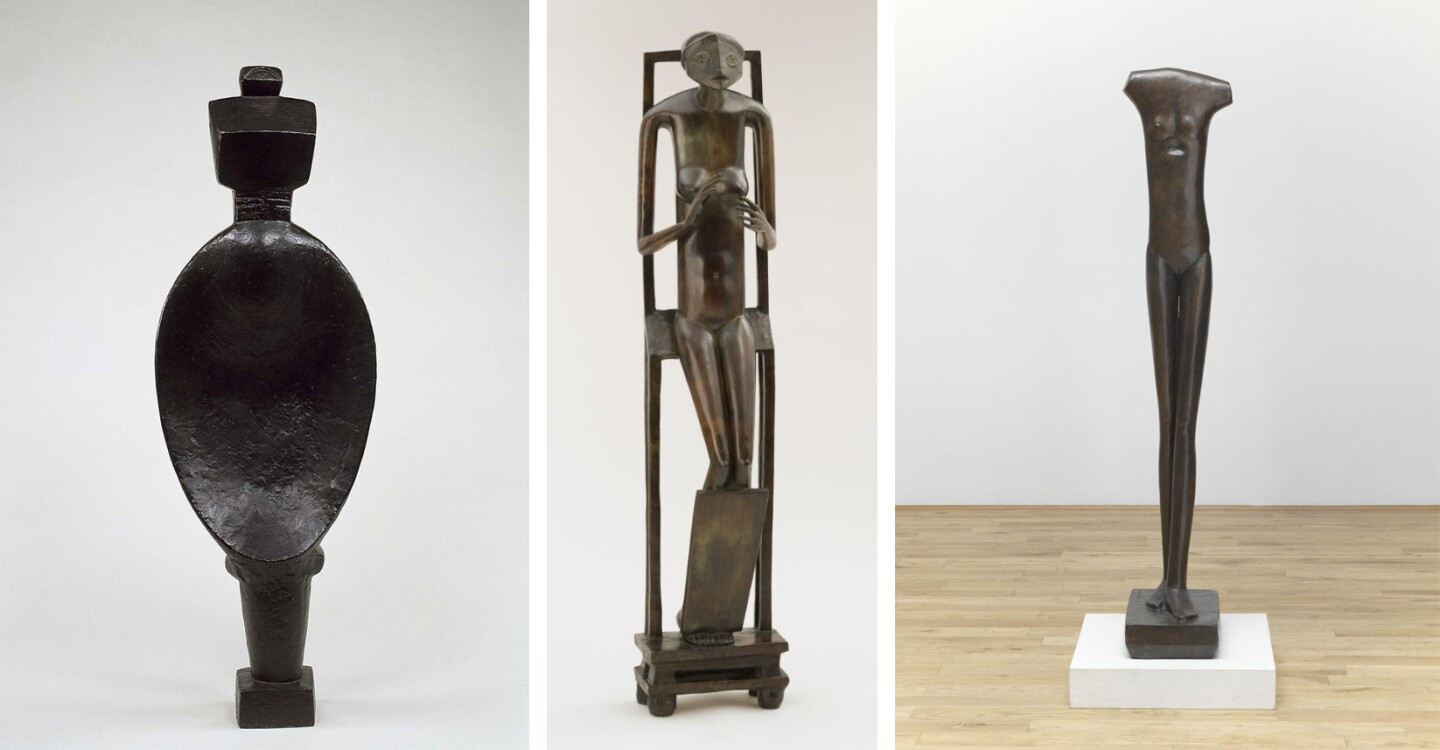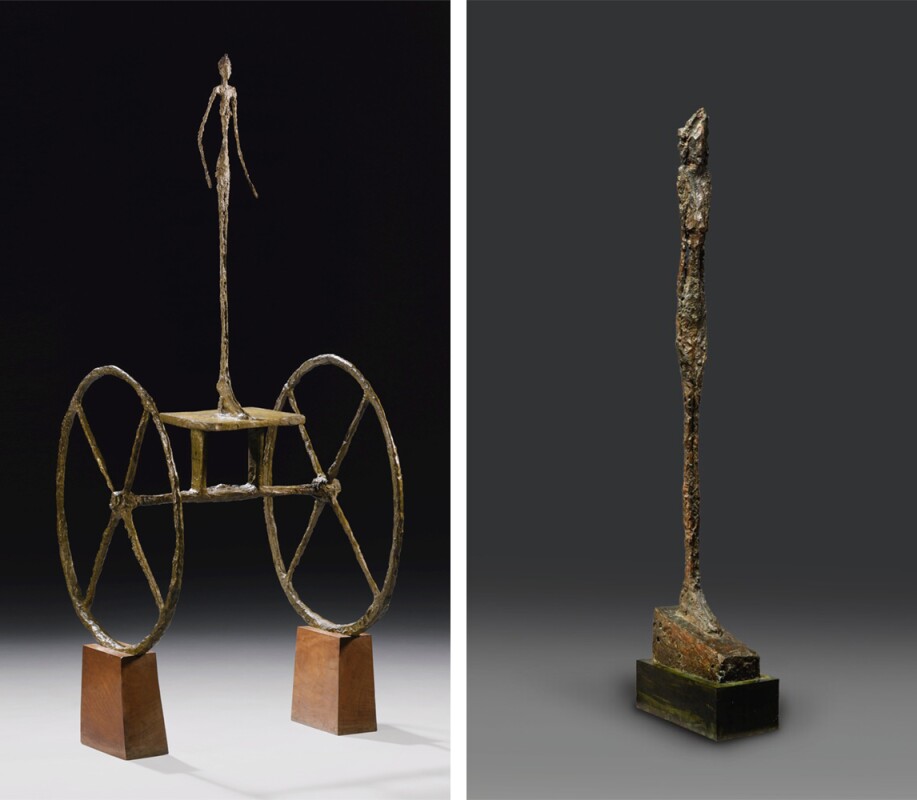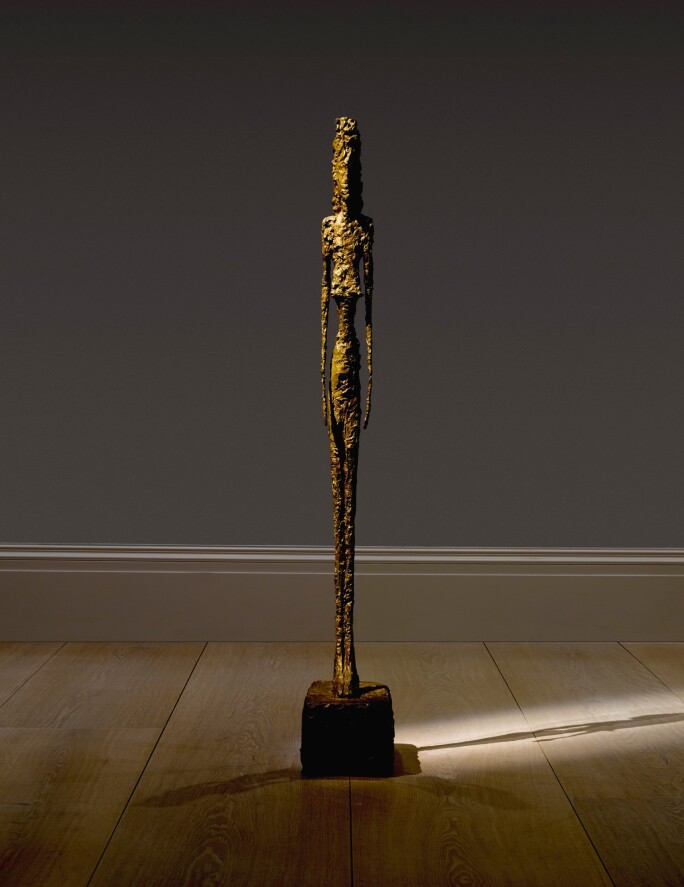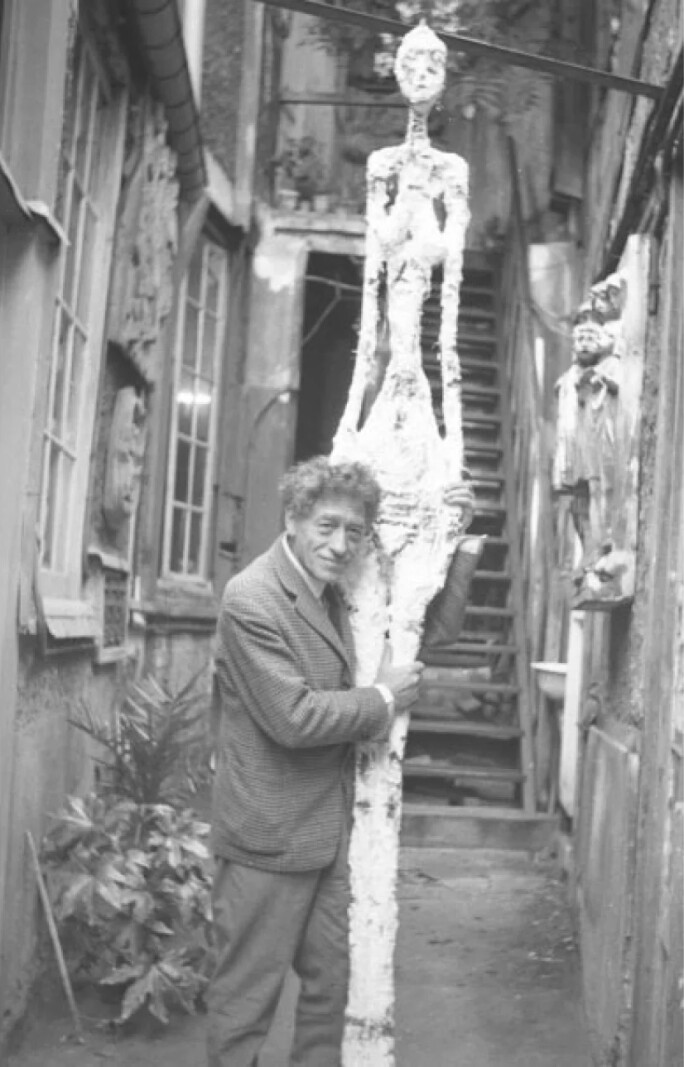A lberto Giacometti’s series of sculptures depicting standing women are among the artist’s greatest contributions to modern art. They have a remarkable presence that captures something of the enduring dignity and grandeur of ancient sculpture. They also have a remoteness and anonymity that speak to the modern age and seem to offer a commentary on the fragile nature of the human condition. While standing female figures appeared in Giacometti’s sculptural work as early as the 1920s, it was the Femmes de Venise — the “Women of Venice” — created in a frenetic period of activity in early 1956, that are the most emblematic of Giacometti’s work. An example from the Femmes de Venise has been included in nearly every major exhibition dedicated to Giacometti’s work since their creation, and one is now being offered at auction at Sotheby’s Modern Evening sale.

Femme cuillère (Spoon Woman) was Giacometti’s first monumental free-standing figure. Inspired by spoons with anthropomorphic decoration produced by the Dan people, based in present day Liberia and Ivory Coast, these spoons served a ceremonial function and were owned by the women who were seen as the most hospitable in the village. Several features of this female figure would continue to inhabit Giacometti’s representations of women throughout his career, including the highly static, frontal pose and the association of women with ancient, powerful figures.
L’Objet invisible, or The Invisible Object (Hands Holding the Void), is a Surrealist nude female figure whose movement is constrained by a bronze frame that serves as both a throne and a prison. This sculpture is Giacometti’s first large-scale female figure to include both arms and a head. The title references an unseen object in the empty space between her hands — this physical sculpture references the intangible. In his initial working of this form, the head was much more naturalistic. Dissatisfied with the effect, Giacometti used a metal mask he found at a market in Paris to form the more abstracted features of the face found in the present work.
Femme qui marche I and Femme qui marche II are two versions of the same sculpture, worked on over a several year period between 1932 and 1936. In what would become a life-long practice, Giacometti consistently refined his forms. The first version originally rested directly on the floor, without the rectangular base that was subsequently added. In addition, the earlier version possesses a hollowed-out section below the figure’s breasts, which is not present in the 1936 plaster held in the Peggy Guggenheim Collection. The lack of head and arms—as well as, in the first version of the work—the indentation below the breastbone, serves to highlight the surreal quality of the sculpture.

Chariot had a profound personal significance for Giacometti; it reflected an epiphany in his creative development. The image came to him from a memory of his Surrealist period of the late 1930s. Like other sculptures from those years, he considered it a product of his unconscious mind, an “automatic” image that arrived fully formed and unmediated. The artist recalled that while recuperating in Bichat hospital after an accident in 1938, he had “marveled” at nurses’ pharmacy wagons with their “tinkling” bells. This sensory image stayed with him, and he drew several sketches that lead ultimately to the present work. As he explained in a letter to his dealer Pierre Matisse, “In 1947 I saw the sculpture before me as if already done, and in 1950 it was impossible not to realize it, although it was already situated for me in the past” (A. Giacometti, 1950, quoted in J. Lord, Giacometti, A Biography, p. 306).
Giacometti’s sculptures, however, were not just a response to the physiognomy of a particular muse. The standing woman and the walking man would form the two most important counterpoints of Giacometti’s mature oeuvre. Femme Leoni was one of the first of the former. As Giacometti’s biographer James Lord wrote:
The year 1947 was a wondrously productive one for Giacometti. … Dominating all the rest [of his sculptures] were those slender, large-footed women. Fresh from the sculptor’s hands, they must have looked very mysterious. Though vaguely reminiscent of certain Etruscan figures, they are not derived from them, being far closer in spirit to Egyptian deities. The great religious art of the world has always been concerned with the female principle, and its masterpieces are possessed by a profound stillness. They do not stir or strive. They simply art. The law of their being is to do nothing but be. Giacometti’s sculptures live by the same law. In ancient Egypt, a sculptor was called ‘one who keeps alive.’ His works were created to represent the idea of eternity, detaching both past and future from the flux of time. They were ‘true’ to life in order to reveal the ‘falsehood’ of death. They made no comment on the how or why of human circumstances but only on the timeless and empirical what. The same may be said of Giacometti’s women.

A rare, unique work, Grande figure relates closely to the other tall figures of 1947 and is among the earliest examples of the slender, elongated female figures that anticipate the iconic later series of women, including the Femmes de Venise (1956) and the Grandes femmes (1960). Throughout the previous decade, Giacometti made regular studies of Egyptian statuary, both in person at the Louvre and working from reproductions. These became important sources of inspiration for creating his frontal female figures and must have influenced his decision to create the present work in a tenebrous gold. Giacometti believed that attempts to mimic reality through techniques like contrapposto preserved an “untruth,” which led him to experiment with the deliberately hieratic forms of ancient sculpture. These, he believed, preserved a truthfulness. As he once proclaimed: “The works of the past that I find the most true to reality are those that are considered the least, the furthest from it” (quoted in Mercedes Matter, Alberto Giacometti, New York, 1987, p. 211).
With the Venice Biennale and another exhibition in Bern both opening in June of 1956, Giacometti set to work producing a group of fifteen standing female figures. Ten of the plaster figures were exhibited in Venice in groups of four and six as “works in progress,” and the remaining five plasters were shown in Bern as Figures I–V. Shortly afterwards, Giacometti selected eight plasters from the Biennale and one from the Bern exhibition to cast in bronze, calling them Femme de Venise regardless of where they had been shown. Two years later in 1958, bronzes of these static figures were exhibited in the United States at the Pierre Matisse Gallery (as seen above). Going forward, few major exhibitions dedicated to Giacometti’s work failed to include at least one of these Venetian women. In its grace and poise, silent majesty and modernity, Femme de Venise VIII, offered in our upcoming Modern Art Evening sale on 13 November 2023, is the epitome of Giacometti’s mature vision and an enduring presence in his oeuvre.

Grande femmes debout are a series of four monumental female figures that Giacometti created for an outdoor sculpture installation in Chase Manhattan Plaza. The installation was never completed, but the four Large Standing Women became iconic nonetheless and have been widely exhibited both independently and as an ensemble since their conception in 1960. Each approximately nine feet in height, these figures were the largest that the artists ever made and are often regarded as the culmination of his life’s work as a sculptor. The initiative for creating this series came about in 1956, when Gordon Bunshaft, the architect for the Chase Manhattan Bank building in New York City’s financial district, asked Giacometti to design a group of sculptures for the building’s large plaza on Pine Street. The figures’ haunting, elongated forms, immobilized by large feet that are firmly rooted to their bases, tower over the viewer with the permanence and fortitude of a giant tree.


